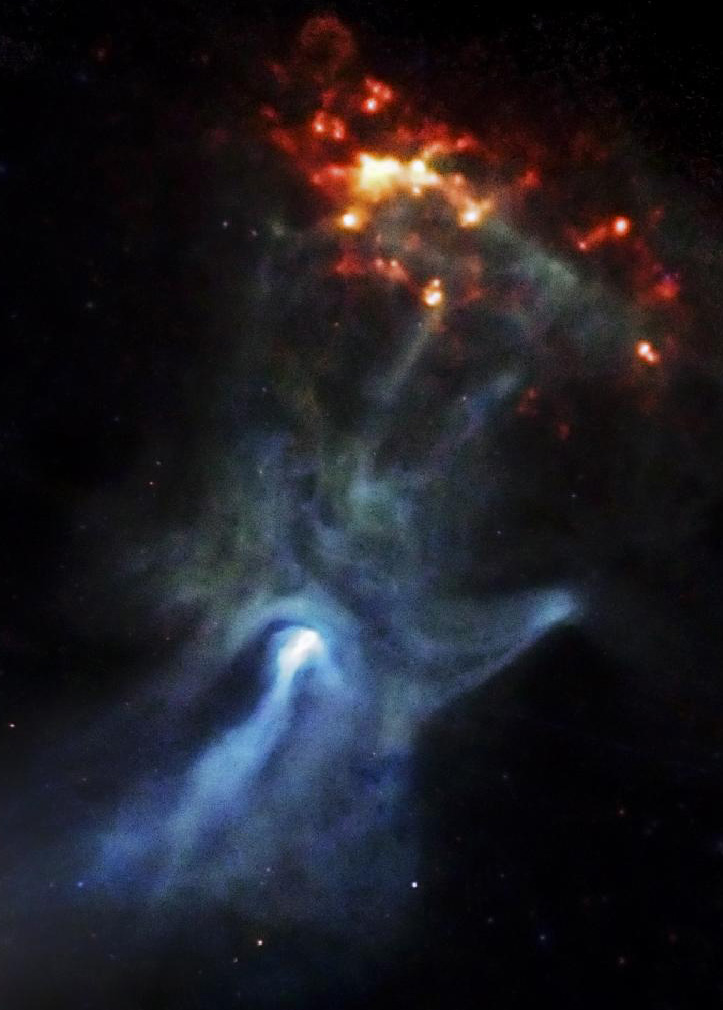Neutron Star Formation Could Awaken the Vacuum
Although empty space teems with quantum fields, their effect is usually subtle. But in the 23 April and 8 October issues of Physical Review Letters, theorists show that under some conditions–such as during the formation of a neutron star–these fields could grow to overshadow any matter in the vicinity. Further exploration of how this “awakening of the vacuum” transpires could transform our view of some astrophysical events.
Empty space is filled with a sort of ghostly quantum-mechanical background of waves of all possible frequencies. These include not only waves of electromagnetism and the other forces, but waves representing particles like electrons. The amount of energy in these waves is small but never zero, like a string that always has some vibrations on it and is never completely still and straight.
Daniel Vanzella of the University of São Paulo in São Carlos, Brazil, and his colleagues wondered how gravity affects the energy contained in empty space. Since there is no complete quantum theory of gravity, they used an established approach called quantum field theory in curved spacetime (QFTCS). This technique uses standard quantum mechanics to describe all of the fields except gravity, and then includes gravitational effects in a different way. According to general relativity, the gravitational force arises from ordinary spacetime being distorted or curved by the presence of mass and energy. So QFTCS uses this relativistic spacetime instead of ordinary space and time for the quantum calculations.
Vanzella and his colleagues didn’t analyze all conceivable fields, just the simplest type, called a scalar field. This field is generic–it could be a simplified version of the electromagnetic field, or it could represent a still-undiscovered particle. Following the standard practice, they left unspecified one key parameter of this field: the “coupling” parameter that quantifies the attraction or repulsion of the field to highly curved regions of spacetime.
In their April paper, Vanzella and graduate student William Lima analyzed the vacuum energy for a spacetime that starts with a uniform distribution of mass in the distant past (flat spacetime) and then evolves to fixed concentrations of mass (clumps) in the distant future. The resulting vacuum energy depends on the mass and size of the clumps, and on the coupling parameter. The surprising result was that for some combinations of values, even after the mass distribution stops changing, the vacuum energy continues to grow exponentially in time in the neighborhood of the clumps. Eventually, the vacuum energy density in these regions exceeds that of ordinary matter, so the vacuum begins to distort spacetime even more than the matter does.
To see whether this effect matters in practice, Lima and Vanzella joined with George Matsas of São Paulo State University in their latest work to examine a model of the highly-curved spacetime that appears during formation of an ultradense neutron star. For some reasonable values of the mass and size of the star, they predict that the vacuum energy will grow within milliseconds for some values of the coupling parameter. At this point the vacuum energy would begin to induce additional gravitational effects, which they haven’t yet calculated, so they don’t know how the star would be affected. If further research shows such a neutron star to be unstable, the existence of stable neutron stars of particular sizes could rule out the existence fields of the type they modeled.
Vanzella cautions that the work so far hasn’t tracked how the growing vacuum energy modifies the curvature of spacetime, nor any resulting effects on the neutron star. “At this point they haven’t done the numerical solution of the Einstein equations with reaction back on the field, so nobody knows where it would lead,” agrees Leonard Parker of the University of Wisconsin in Milwaukee. “It’s an invitation for some further research.”
–Don Monroe
Don Monroe is a freelance science writer in Murray Hill, New Jersey.
More Information
2001 Focus Story on measurements of the Casimir force that results from changes in the vacuum energy.





